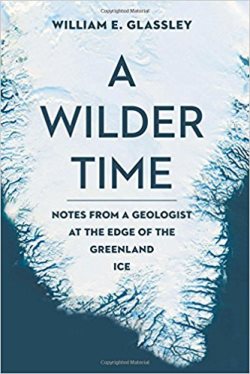 A Wilder Time
A Wilder Time
Geologist Bill Glassley (University of California, Davis) has spent six field seasons studying some of Earth’s most ancient rocks in one of its remotest wildernesses. Many will rightly envy him, and his brief but ambitious book demonstrates that there’s nothing like being a geologist for taking you to unfrequented places, at other people’s expense.
The area he explores in his new book, out this month, with Danish colleagues Kai Sørensen and John Korstgård, is vast; a segment of Greenland’s coastal fringe of ice-smoothed rock and periglacial tundra that extends like a valance around its vast central ice cap. Plucked from civilization, our heroes find themselves marooned in this wilderness, alone in the short summer’s perpetual day, where land feathers into arctic sea, ice floes glide by on mirror-smooth tongues of clear, frigid water, and nature’s eternal silence reigns.
What drew the companions there may sound, by contrast, like a storm in an academic teacup. Someone (tactfully unnamed) had published a paper attacking the established geological view of the ‘Nagssugtoquidian Mobile Belt’. As geologists we are familiar with these jaw-cracking Inuit place-names, many ending in the ‘oq’ sound, which the late Stephen Moorbath FRS once described to me as ‘like a piano string being cut at the bottom of the ocean’.
Moorbath helped make the area famous by finding what are still among the oldest known rocks on Earth. Arthur Escher and Juan Watterson mapped these high-grade metamorphic mélanges of altered sediments, mantle rocks and ocean-floor basalts almost 3.5 billion years old in the 60s and 70s. Feiko Kalsbeek, Bob Pidgeon and Paul Taylor, in the 1980s, whose plate-tectonic interpretation (describing the distinctive East-West shear zones as sutures left by the most ancient plate-tectonic collisions on our planet) was now apparently in doubt.
Such is the scientific narrative underpinning Glassley’s book, which arrives at a satisfying conclusion, demonstrating how the team vindicated and even refined the original model, putting its assailants to flight. But the science is almost the maguffin here.
Natural scientists may well be the only intellectuals to find themselves routinely exposed to the transformative experience of wilderness these days. Yet (as I have observed myself) on many it seems completely wasted. This may not be their fault. Expeditions, like the ones Glassley describes, teach you how travel narrows the mind. But Glassley’s vivid subjective impressions attempt what few scientist-writers do: to explore beyond his science’s normal comfort zone.
Mediaeval scholastic philosophers, following Duns Scotus, coined the terms haecceity (‘thisness’, of specific things) and quiddity (‘whatness’, of the classifier). They are ‘science’. But Glassley tries also to grasp something beyond - the noumenon - an ineffable inner reality that cannot be discerned by vulgar senses. Glassley seems preoccupied with our limitations when it comes to grasping the wholeness of the world - questioning how our ‘reality’ contrasts with, say, a seal’s, or a fish’s. Absenting himself from camp, he wanders alone with his reflections, and attempts closer communion with the hidden genius of place.
Although he repeatedly explains what he’s attempting (a scientist’s tendency to write abstracts for everything, perhaps) he is not always successful. What he gropes for requires art, not analysis. Perhaps that was why I kept returning to Hugh MacDiarmid’s great poem, On a raised beach, which also grapples with nature, science and metaphysics via a more successful medium. After an opening parody of scientific language, the poet observes:
Deep conviction or preference can seldom
Find direct terms in which to express itself.
Reviewed by: Ted Nield
A WILDER TIME – NOTES FROM A GEOLOGIST AT THE EDGE OF THE GREENLAND ICE, by WILLIAM E GLASSLEY. Bellevue Literary Press, New York February 2018. 222pp. W: www.blpress.org
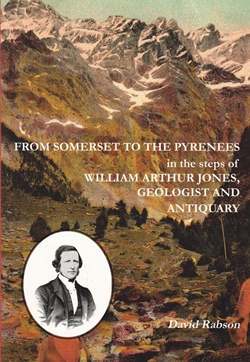 From Somerset to the Pyrenees
From Somerset to the Pyrenees
As noted in the introduction: “A great flowering of interest in archaeology, local history, and the natural environment took place in early Victorian England”. Jones, the youngest in a Unitarian family in Carmarthen, Wales, was born in 1818, nicely in time to participate in that flowering. His diaries show that his broad interests, in geology and natural history in particular, began before he went to Glasgow University aged 20, to study for life as a minister in the Unitarian church.
Having graduated, he moved to ministry in southern England, joining the Somerset Archaeological and Natural History Society in 1849, when he moved from Northampton to Bridgwater. He became the Society’s general secretary in 1853 and remained an office-holder until his death, in Taunton, in 1873. His time in the Pyrenees, arising from a need to deal with illness in his family, lasted from October 1866 to July 1868.
As for most of us, the records of Jones and his families’ travels seem to be rather patchy, making this a difficult biography to compile because of the relative paucity of evidence and/or information. He was a well-travelled man in an age when travelling was difficult, although it became gradually easier as time (and his life) passed – when he went to Glasgow in 1838 he travelled from Swansea by sea via Liverpool and Greenock. The book takes the reader through his life from his childhood and youth in Carmarthen, university days in Glasgow, and on via Northampton, where he spent several years (including about six months touring northern Europe after his first wife died - they had been married for less than five months), to Somerset, were he lived for some 24 years (including the time in the Pyrenees).
The book is well illustrated with pictures ranging in age from early- to mid- 19th Century sketches and photographs, to modern-day images. There are also half a dozen appendices, including a list of papers given/presented by Jones. Sadly, however, there are no quotations or extracts from the papers, and the book contains no comment on technical or other issues in relation to any of them. Summaries – the abstracts, if they exist – would have been interesting, along with, perhaps, a little more about perceptions in geology, natural history and archaeology when Jones was active.
Reviewed by Jeremy Joseph
FROM SOMERSET TO THE PYRENEES – IN THE STEPS OF THE REVEREND WILLIAM ARTHUR JONES, GEOLOGIST AND ANTIQUARY by DAVID RABSON, 2015. Published by: Somerset Archaeological & Natural History Society, Norton Fitzwarren, Somerset, UK. ISBN: 978-0-902152-28-1. (Pbk.) 109pp. List Price: £14.95. W: www.freewebstore.org/SANHS
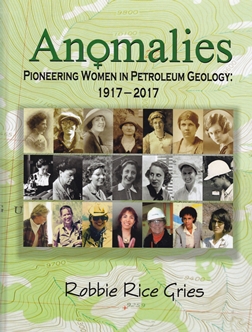 Anomalies – Pioneering Women in Petroleum Geology: 1917-2017
Anomalies – Pioneering Women in Petroleum Geology: 1917-2017
If like me, you thought females were scarce in the early petroleum industry you will have your eyes opened by this well-illustrated book. However, the inevitably American focus must be taken into account when reading it; WWI and WWII (dated as beginning in 1917 and 1941 respectively), requiring American oil companies to employ women. The first were hired by Roxana during WW1 - as employees not consultants. Read about Reba Masterson, the first female petroleum geologist.
In this female perspective of the oil industry history, Robbie Gries looks at available geological education. As in the UK, women could take geology classes during the early 20th Century but not graduate in the subject until 1919. After setting the initial context, the author provides small biographical studies of 149 female petroleum geologists (87 of whom are dead).
One outstanding woman - Julia Anna Gardner (1882-1960) - has her own chapter. She was the first petroleum biostratigrapher. She was taught by Frances Bascom at Bryn Mawr, published over 40 papers and has three fossils named after her, including the State Gastropod of Maryland. (Did you know Maryland had a State Gastropod? Perhaps we should have county fossils for UK.) During WWII, she used her knowledge of palaeontology to identify sand ballast shells in incendiary bombs from specific beaches in Japan.
The Interwar years saw increasing numbers of women employees in the petroleum industry. Katherine Woodley Carman, who died in 2008 aged 102, was an accomplished micropalaeontologist, obtaining a geology PhD from MIT in 1929. She was an AAPG member for 82 years - surely a record!
As in the UK, it was difficult for a woman to remain in position if she married, and many women quit their jobs to become consultants. The impact of Affirmative Action (1973) on hiring women is illustrated by the fascinating story of the author herself - who ended up running her own oil company in Denver. The book ends with 11 management ‘rock stars’ who were a result of the American 1980s Equal Employment Opportunities Commission. Similar legislation in the UK was passed in 1975.
The amount of research undertaken for this book is phenomenal, allowing the subjects to come alive as we see them in their work clothes or struggling with drill bits. Robbie Gries calls this book ‘a celebration of 100 years of individual courage, fortitude and professionalism’. She recalls her own journey to discover lost stories of pioneering women. She does a remarkable job. I found this book readable and rewarding - perhaps not as a single read, but to enjoy over time. After all, it was 100 years in the making.
Reviewed by: Cynthia Burek
ANOMALIES – PIONEERING WOMEN IN PETROLEUM GEOLOGY: 1917-2017 by ROBBIE RICE GRIES, 2017.Published by JeWel Publishing LLC405pp (hbk) ISBN: 9781936499090 List Price: $50.00 W: www.jewelpublishing.com
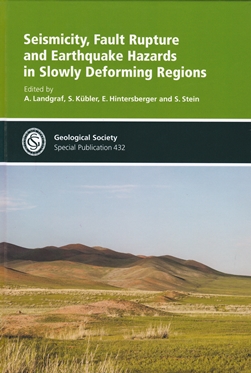 Seismicity, Fault Rupture and Earthquake Hazards in Slowly Deforming Regions
Seismicity, Fault Rupture and Earthquake Hazards in Slowly Deforming Regions
This publication includes 13 papers from topics related to applied seismology, geodesy, earthquake hazard assessment and earthquake geology in slowly deforming (intraplate) settings. None of the papers appears to cover any one topic in detail. Rather, a few of the papers give insight into a few issues, including some in specific geologic settings. The title could have been used for a three-volume set, each volume taking one topic, leading to a final series of papers addressing seismic hazard assessment in slowly deforming regions verses active fault margins.
The lead paper addresses areas of slowly deforming regions at a regional level, noting that in some cases a fault or fault-related features may have been partially eroded, buried, or have extremely long reoccurrence intervals. Areas with currently higher strain rates may have more sharply pronounced crisp fault-related features. It is noted that this is not always the case, since faults can migrate; and faults away from areas with currently large strain-rates have experienced a number of large earthquakes in both the historic record as well as in prehistory (as in parts of central Asia and elsewhere).
Of the papers presented, several merit specific attention; however, the room in this review is limited. Five of the volume’s papers were devoted to work in central Asia. This set of papers helps to fill in both the historic and palaeoseismic records in, or near, the Tien Shan Mountains in Northern Kyrgyzstan and Southern Kazakhstan or in the Hangay Mountains of Mongolia. This is a relatively important study region since so many large magnitude earthquakes are known to have occurred there either in historic times or in the Holocene. This is a region that is not heavily populated or well mapped or instrumented. None of the papers covers the entire geologic setting of the Tien Shan or Hangay Mountains. The collection is a very helpful resource on a regional scale. I also found a paper on the influence of groundwater recharge on naturally occurring intraplate earthquakes to be a great primer to the subject.
Reviewed by: Robert Anderson
SEISMICITY, FAULT RUPTURE AND EARTHQUAKE HAZARDS IN SLOWLY DEFORMING REGIONS by A LANDGRAF, S KÜBLER, E HINTERSBERGER AND S STEIN (eds) 2017 Published by the Geological Society, ISBN: 978-1-86239-745-3 List Price: £100 Fellows Price: £50 W: https://www.geolsoc.org.uk/SP432
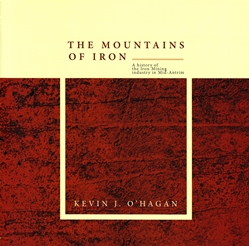 The Mountains of Iron: A History of the Iron Mining in Mid-Antrim
The Mountains of Iron: A History of the Iron Mining in Mid-Antrim
Kevin J O’Hagan has spent many years meticulously researching the history of iron ore mining in and around Mid-Antrim, and he has backed this up with his own experiences exploring and recording old underground workings. It is obvious from the onset that he has the knowledge and passion for the industry. Cornwall is acknowledged nationally as the home of hard-rock mining and the cradle of the steam engine. The bleak hills of the Antrim Plateau have previously been completely overlooked, and now it’s only marked by red spoil-heaps.
With iron ore mining these days mostly taking place in large-scale open pits, it is nice to hear a great storyteller tell us how it was once conducted. This fascinating study in the microcosm of the birth, development, and decline of the mining traces the rise of Mid-Antrim from its first underground mine in 1867 through its glory years and to its effective demise after the Second World War. Like virtually all other successful mining communities, it was entrepreneurs of vision and courage, willing to take great risks, who were essential to the founding and survival of the mining towns.
O’Hagan is perhaps at his best when describing the lives of the average working men and women who populated these towns; but a lot of time is spent discussing the technology advances introduced in the mines, including the Irish narrow-gauge railway and a wire tramway devised to minimise costs and ground preparation in hauling ore. This book is a model of how to present the findings of personal investigation. O’Hagan’s voice is that of the patient researcher, ever mindful in his sifting of materials. Packed with photos, diagrams and historical documents, mine economics and mining methods are also discussed.
Mining is beginning to re-appear in Northern Ireland, with early stage PGM exploration as well as feasibility studies on a gold mine close to Omagh. From a geologist’s viewpoint it would have been nice to see more information on the geology and formation of the deposits, and a couple of maps. But all in all, this is a very compelling story, told extremely well. It would appeal to an audience with an interest in history of mining and local history in Northern Ireland.
Reviewed by: Jason Holden
THE MOUNTAINS OF IRON: A HISTORY OF THE IRON MINING IN MID-ANTRIM by KEVIN J O’HAGAN, 2016. Published by: Shanway Press 140pp (pbk) ISBN:9781910044124. List price: £12.99 W. http://shanway.com/product/the-mountains-of-iron/
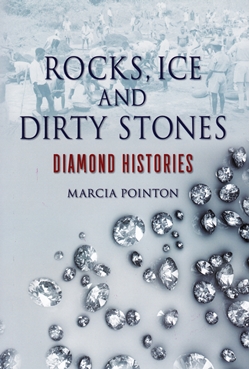
Rocks, Ice and Dirty Stones – Diamond Histories
The author, Professor Emerita in History of Art at the University of Manchester, admits that this book is not a technical treatise but an exploration of the social, artistic and commercial aspects of diamonds through the ages.
She begins with short histories of diamond mining in India, Brazil and South Africa, concentrating heavily on the working conditions and suffering of the labourers, often slaves, but omitting to mention of how organised, safe and environmentally responsible the vast majority of diamond mining in modern times is. This unfortunately co
nveys the false impression that this sorry history is reflected in modern-day practice.
In a short history of the De Beers organisation, she repeats the shibboleth of De Beers using its ‘vast stocks’ to manipulate rough diamond prices using Edward Jay Epstein (a controversial commentator) as a source. She also carries out an overview on ‘conflict diamonds’ and the perceived shortcomings of the Kimberley Process, giving credence to Global Witness and dismissing De Beers’ comments.
On safer ground, she describes how diamonds have figured throughout history, going back to Pliny the Elder and before. She is at her best when relating stories, such as her short histories of the Koh-I-Noor and the Cullinan. The section on how the global trade grew during the 16th and 17th Centuries is particularly interesting.
Professor Pointon devotes a chapter to how the shape of diamonds in particular, and the rhombus in general, has figured in art and design and in religious symbolism. This is clearly her forte and this section is both instructive and entertaining.
She then covers the culture of the diamond engagement ring. While diamonds have been given as symbols of love since time immemorial, it was the discovery of large supplies in Brazil that led to a nascent commercial market, its subsequent expansion after the First World War, culminating in the famous slogan ‘A diamond is forever’, dating from the 1940s. The final chapter in the book contains some interesting stories of diamond thefts, both factual and fictional.
I feel that this is ‘two books in one’ and therefore a mixed bag. The author brings nothing new to our knowledge of the diamond market as it operates today but she is a good storyteller and historian. I would recommend this book to someone who has no knowledge of diamonds - but advise them not to treat her observations on how the modern market works as gospel.
Reviewed by: Nigel Combley
ROCKS, ICE AND DIRTY STONES – DIAMOND HISTORIES by MARCIA POINTON, 2017. Published by: Reaktion Books 256pp (hbk) ISBN: 978 1 78023 752 7 List price £25 W: www.reaktionbooks.co.uk